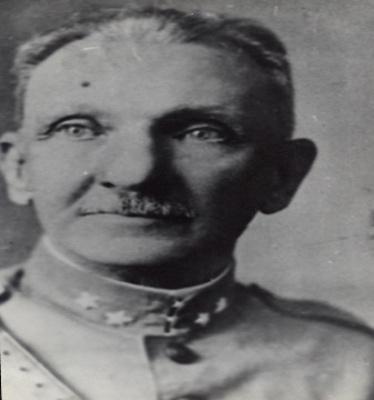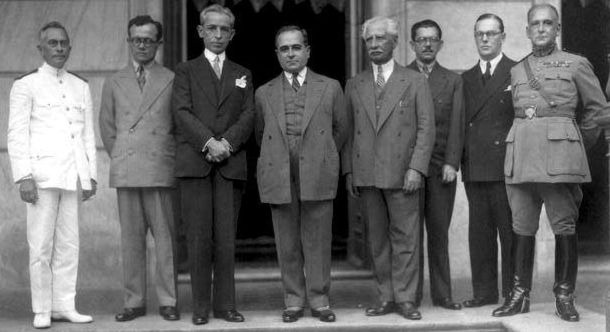THE Constitutionalist Revolution was an armed movement started on July 9, 1932, led by the state of São Paulo, which defended a new Constitution for Brazil and attacked the authoritarianism of the Provisional Government by Getúlio Vargas. During for nearly four months, the paulistas clashed with troops loyal to Vargas and, isolated, they were defeated. The uprising was not in vain, as in 1934 the new Brazilian Constitution was enacted.
Read too: Vargas Era – 15-year period in which Getúlio Vargas ruled Brazil
historical background
THE 1930 revolution marked the arrival of Getúlio Vargas to power, installing the Provisional Government. Vargas then canceled the Constitution of 1891, closed the National Congress, extinguished political parties and began to rule through decree-law. In the states, Vargas deposed the former governors and appointed interventors, people he trusted, to govern each Brazilian state. A striking feature of this historical period is the participation of civilians and military in politics, in several cases the two groups came into conflict. In 1924, São Paulo was the stage for a military movement aimed at taking power, but the rebels were defeated.
Vargas, as head of the Provisional Government, accumulated powers. Without an open Congress and parties operating in the political field, he began to dislike former supporters of the 1930 Revolution, as his government centralized powers. No presidential elections were called, the promised National Constituent Assembly did not take place, that is, Brazil did not have a Constitution. Furthermore, the interventors chosen to govern the states did not please local politicians. An example of this was São Paulo.
The Paulistas saw in the choice of interventors an interference by Getúlio Vargas in the states. Autonomy was at risk, as the rulers were not chosen by their politicians, but by the head of the Provisional Government, which began to do this since 1931, naming military interveners (or linked to the military).
On May 23, 1932, a demonstration against the Vargas government took place in downtown São Paulo. The forces loyal to the government reacted, killing four students: Mário Martins Almeida, Euclides Miragaia, Dráusio Marcondes de Sousa and Antônio Camargo de Andrade. Violence against protesters increased the support of the São Paulo middle class for the constitutionalist cause and against the government. The surnames of the dead were immortalized in the acromion: MMDC.
![The surnames of those who died in the anti-Vargas demonstration in São Paulo became a symbol of the 1932 Revolution.[1]](/f/2e1ff5f37a89fa4f62adbffcae02965b.jpg)
Participants in the Constitutionalist Revolution of 1932
Euclydes de Figueiredo, a participant in the movement, wrote in his book, Contribution to Hhistory of the Constitutionalist Revolution of 1932, that, until the beginning of the confrontation, Sao Paulo had the support and sending of troops from Mato Grosso and Rio Grande do Sul, states that also showed dissatisfaction with Vargas' authoritarianism. However, when the fight started, both opted for the Vargas side, abandoning the São Paulo team.
![Poster produced during the Constitutionalist Revolution that called for the participation of the entire São Paulo society in the struggle against the Vargas government. [1]](/f/a2db28bdd10b231e6c77d64791d4ac80.jpg)
On July 9, 1932, São Paulo troops began the armed struggle led by General Isidoro Dias Lopes. Interventor Pedro de Toledo, Vargas at the beginning of his administration, soon after the beginning of the conflict, changed sides and supported the constitutionalists. The revolutionaries organized a intense advertising campaign asking for support from the population for the conflict to succeed. Young people were summoned to fight on the battlefields, and industrialists suspended their production and started manufacturing weapons for the confrontation.
To finance São Paulo soldiers, the São Paulo's Gold for Good Campaign, in which the population was called upon to donate their valuables in favor of the constitutionalist cause.

The support of the gauchos and Mato Grosso did not come, and the paulistas had to fight alone. The government of Minas Gerais also supported the struggle in defense of the Constitution, but preferred to side with Getúlio Vargas. The suspicion that the Paulistas were fighting for the independence of the state diminished the support of other Brazilian states for the uprising.
Do not stop now... There's more after the advertising ;)
armed conflicts
The conflicts took place mainly in the Vale do Paraíba region, on the borders of the states of São Paulo, Rio de Janeiro and Minas Gerais, mainly on the border between São Paulo and Minas Gerais. The São Paulo troops tried to resist the onslaught of the Vargas forces, with the São Paulo capital being attacked by government planes. The creator of the plane, Alberto Santos Dumont, lived in Santos, a city on the coast of São Paulo, and, when he learned that his invention was used to kill fellow citizens, he committed suicide on July 23, 1932. Several young fighters lost their lives during the fighting. Many have not had training necessary to act on the battlefield, taking up arms only for the constitutionalist cause, as Euclydes Figueiredo recalls.

The south of Minas Gerais registered intense combats. The Minas Gerais troops were moved to the region of the city of Passa Quatro, to attack the people from São Paulo who were already reaching the territory. Mineiros and paulistas fought intense battles in a railway tunnel that became known as the Mantiqueira Tunnel.
Two personalities who would stand out in national politics in the following decades acted in this place. Benedito Valadares he was the chief of police of one of the military detachments of Minas Gerais. Soon after the conflict, Valadares gained the trust of Getúlio Vargas and was named interventor of Minas Gerais. Juscelino Kubitschek participated in the combat as a doctor. He attended to the wounded in field hospitals. It was during the 1932 Revolution that the two met. Upon taking over the Interventoria de Minas Gerais, Valadares appointed Kubitschek to be mayor of Belo Horizonte.
See too: Intentona Integralista - organized rebellion during the Vargas era
End of the Constitutionalist Revolution
In 1O October 1932, almost four months after the conflict began, the paulistas surrendered, as they no longer had enough soldiers and supplies to keep up the battle against the Provisional Government. The military forces loyal to Vargas defeated the São Paulo troops. The balance of the war was 934 lives that died in the fight for the constitutionalist cause. These numbers refer to what was officially published, but there are records of more deaths.
You main leaders of the revolution had their political rights revoked and were deported to Portugal. It was a way for the government to remove from São Paulo those who motivated the armed struggle against the central power.
Consequences of the Constitutionalist Revolution
Despite being defeated militarily, the Paulistas got what they wanted. In 1933 the National Constituent Assembly was held, that drafted a new Constitution for Brazil, which was promulgated the following year. The National Congress was reopened, political parties returned to function, and Getúlio Vargas was elected President of rpublic through indirect election. Thus ended the Provisional Government and began the Constitutional Government, in which Vargas began to govern Brazil under constitutional guidelines.
Vargas did not move away from São Paulo after the uprising. As the state was the most economically developed, the Provisional Government maintained the coffee valorization policy, an attempt to save coffee growers from the effects of 1929 crisis. The economic factor was fundamental in bringing Vargas closer to his former enemies.

The Paulistas finally had a civilian as interventor. In August 1933, Setting Sales he was appointed interventor and, in 1935, he was elected constitutional governor. Sales convened a Constituent Assembly that drew up a Constitution for the andstate of São Paulo.
THE memory of the Constitutionalist Revolution of 1932 is yet valued by paulistas. The 9th of July, the date on which the movement began, is a state holiday. In the city of São Paulo, there are several references to the revolution, such as streets, squares and viaducts named with the names of the combatants, in addition to the monument erected near Ibirapuera Park, where the mortal remains of those who died fighting for the Constitution.

solved exercises
Question 1 - In 1932, the Paulistas revolted against the Provisional Government, whose head was Getúlio Vargas. Check the alternative that correctly points out the causes of this conflict:
a) The people of São Paulo revolted because they wanted a fellow countryman in the presidency of the republic and not a gaucho like Getúlio Vargas.
b) The Provisional Government had not supported the coffee growers, who had been suffering the shocks of the economic crisis since 1929.
c) The 1932 Revolution had as causes the promulgation of a new Constitution for Brazil and the end of the authoritarianism of the Vargas government.
d) The constitutionalists wanted the annulment of the 1891 Charter and the formation of another one.
Template
Alternative C. The Paulistas took up arms against the Vargas Government because they did not accept the Interim Government's interference in state decisions and wanted a new Constitution for Brazil.
Question 2 - Mark the alternative that points out the ways in which the Paulistas participated in the Constitutionalist Revolution of 1932:
a) All men were obliged to take up arms and fight for the Constitution.
b) Women over the age of 18 were forced to work in the wards to care for the war wounded.
c) Paulistas received funds and weapons from other states.
d) Young people enlisted to participate in the confrontation, factories began to produce products for the battle, and the donation of gold was encouraged to finance the conflict.
Resolution
Alternative D. Those who did not effectively participate in the conflict were able to collaborate by donating gold or jewels to finance the revolution. Factories stopped their production to make equipment for the fight. An intense campaign was carried out so that all Paulistas, in every possible way, could help in the fight against the Provisional Government and for the Constitution.
Image credit
[1] CPDOC/FGV
By Carlos César Higa
History teacher

